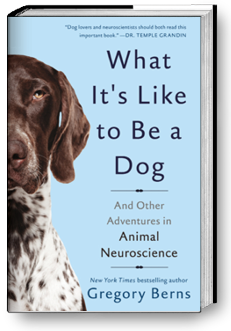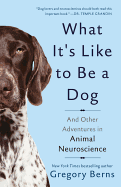What It's Like to Be a Dog: And Other Adventures in Animal Neuroscience
by Gregory Berns
After 30 years in the sciences, first as a physician and eventually as a specialist who studied the workings of the human brain, Dr. Gregory Berns pondered a question that would change the course of his career: Can a dog be trained to lie inside an MRI scanner? The question arose from the saddest of circumstances: Newton, his favorite dog, had died recently. Berns found himself wondering about their relationship: "Had Newton loved me in the same way I had loved him? Or had it all been a sham, an innocent duplicity propagated by dogs to act all cute and stuff in exchange for food and shelter?"
His desire to find answers gave rise to the Dog Project, a scientific study of how dog brains--and the brains of other animals--actually work. He captures the most intriguing experiments and results of the Dog Project in his latest work, What It's Like to Be a Dog and Other Adventures in Animal Neuroscience. The book builds on his previous book, the New York Times bestseller How Dogs Love Us, by explaining in smart but easily accessible language the history of psychological experimentation that informed the Dog Project, and what he learned from the study. Both aspects of the book--the descriptions of the experiments and their astonishing conclusions--are equally fascinating.
Berns's argument that MRI scans, which until now had been used almost exclusively on humans, can reveal much about a dog's inner world is persuasive from the first page. After a brief overview of other psychologists' successful MRI experiments on humans, Berns writes: "[These] techniques proved that, without a doubt, measures of physical activity in the brain could be translated into discrete mental states... [and]... if these techniques worked for humans, there was no reason why similar approaches couldn't be used to decode animal states of mind. Knowing what it was like to be a bat, or a dog, began to seem like a real possibility."
One of the Dog Project's first experiments involved training the dogs to complete a Go-NoGo task, an experiment drawn "from the field of human psychology" that "even children could do." At base, the experiment required the dogs to behave differently to two different but similar types of stimuli: when a dog heard a whistle, it was to poke a target with its nose inside the scanner. But when that same sound was accompanied by the presence of its owner standing with arms crossed, the dog was to lie perfectly still. The experiment was designed to light up the part of the dog's brain that operates self-control and, for the most part, the dogs cooperated at impressively high rates.
Among the book's highlights is its description of how individual dogs behaved in the lab. Each canine participant proved to have its own personality, and often, the results of the experiments seemed at odds with those personalities. That was a lesson in and of itself: "[O]nce again," Berns writes when describing a particularly surprising result, "I had fallen into the trap of thinking like a human instead of a dog."
Berns also describes successful experiments conducted with other animals. In one standout chapter, he introduces us to Ronan, a California sea lion that was weaned too early from her mother and therefore had grown dependent on food from humans. Rescuers from the Marine Mammal Center recognized that her behavior put her in harm's way and brought her to their facility, where she became a subject in the experiments of animal scientist Dr. Peter Cook. Cook sought to determine whether animals could follow a musical rhythm, and Ronan, always eager to please, seemed up to the challenge. I won't spoil whether she ultimately learned to bop to the beat, but I will say that Berns's descriptions of Ronan listening to Creedence Clearwater Revival, the Backstreet Boys and Earth, Wind, and Fire are a delight.
The success of Berns's experiments and those of others in the field have led to additional animal behavior studies, and while not all of them have generated the results that Berns has hoped for, the majority point toward the existence of animal feelings and thought processes both richer and more complex than most scientists previously thought possible.
It's this proof that animals can feel and understand more than we realize that Berns hopes will change the way humans treat all animals, not just dogs. But he remains unconvinced that the Dog Project alone will have much influence: "I am not so naïve to believe that neuroscience will result in a flurry of legal changes for animals. The legislative and judicial spheres are notoriously resistant to science, not so much because people don't believe in science--although many do not--but because laws generally reflect society's moral intuitions. Laws aren't made because science proves something. Laws are made because enough people believe something is right or wrong." That's one reason why Berns has developed the Brain Ark, a project that involves collecting the brains of deceased animals for further study. Berns discusses the initiative in a moving epilogue that also touches upon the importance of the ark in the face of potentially devastating climate change. "Our goal," he writes, "is to catalog and describe the brains of the Earth's megafauna before they are gone."
Informative, entertaining and at times deeply moving, What It's Like to Be a Dog is an eye-opening and necessary addition to the literature of popular animal science. --Amy Brady








.jpg)